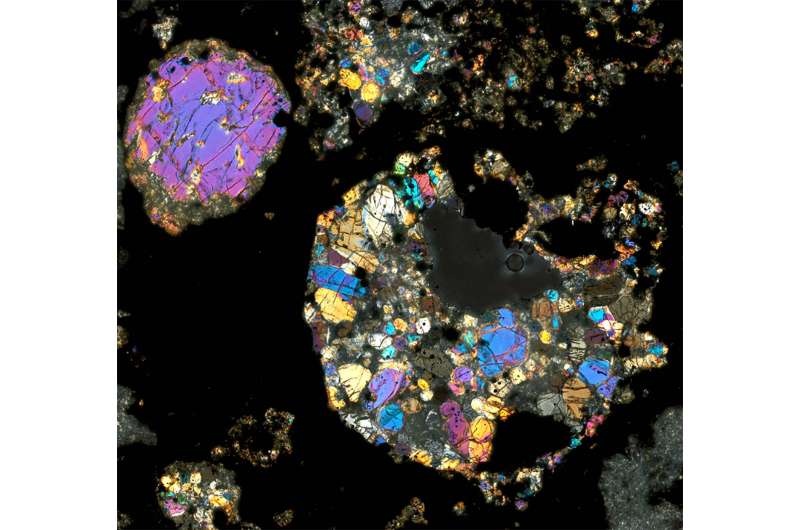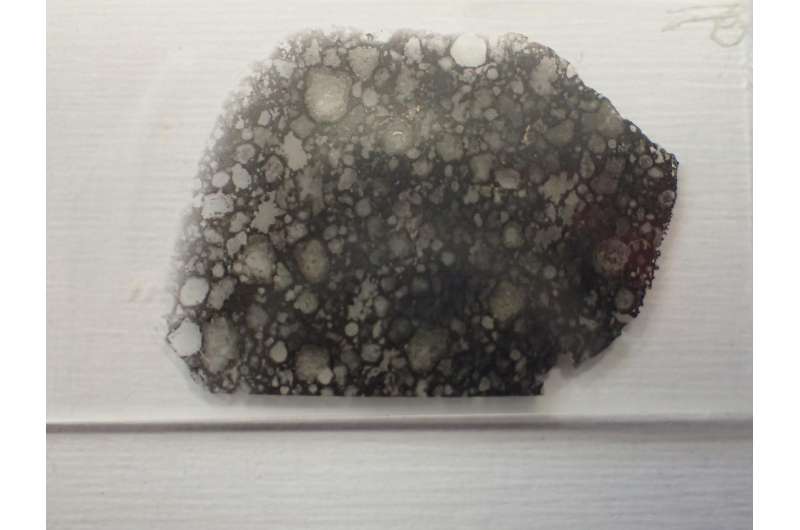July 4, 2016 report
Chondrule evidence suggests ancient low-velocity collisions between rocky planetesimals and icy bodies

(Phys.org)—A small team of researchers with members from institutions in France and Japan has found evidence in chondrules that suggest their existence came from collisions between planetesimals in the inner part of the solar system and icy bodies on the periphery, approximately four and a half billion years ago. In their paper published in the journal Science Advances, the team describes their work with two previously found meteorites and their study of the chondrules within them.
Space scientists have been studying meteorites for many years as part of their attempt to understand the nature of the universe—one type, chondrites, hold glassy looking blobs of material in their interior, called chondrules, which come to exist, it is believed, when molten droplets of different types of material cool. Such objects are also believed to belong to a class of some of the oldest known materials in our solar system. In this new effort, the researchers focused on two chondrites named Kaba and Vigarano.
In taking a close look at the chondrules within, the researchers found that they were made of sulfide-associated magnetites of magmatic origin, more commonly known as SAMs, something that had never been seen in a chondrule before. This, and their unique shape, the researchers contend, suggests that they could have been created only under conditions where oxidizing was occurring, and the only viable scenario where that could have occurred in the early solar system was where rocky planetesimals left the inner part of the solar system and ventured to its outer reaches where they eventually collided with icy bodies. Such collisions, the team notes, would have been relatively low velocity, because olivines were still present—a high speed collision would have caused such material to vaporize.

The team built a model to better understand how such collisions could occur and after studying their results theorize that such collisions could have come about due to the presence of a gas giant, such as Saturn or Jupiter—as it formed, it could have caused other objects to be jerked around, resulting in some being flung great distances.
The findings by the team suggest that not all chondrules were made from primitive dusk present in the early solar system disk—some may have come about due to collisions. The team plans to continue their study of chondrules looking for evidence that shows that collisions are the main process driving their formation.
More information: Y. Marrocchi et al. Early scattering of the solar protoplanetary disk recorded in meteoritic chondrules, Science Advances (2016). DOI: 10.1126/sciadv.1601001
Abstract
Meteoritic chondrules are submillimeter spherules representing the major constituent of nondifferentiated planetesimals formed in the solar protoplanetary disk. The link between the dynamics of the disk and the origin of chondrules remains enigmatic. Collisions between planetesimals formed at different heliocentric distances were frequent early in the evolution of the disk. We show that the presence, in some chondrules, of previously unrecognized magnetites of magmatic origin implies the formation of these chondrules under impact-generated oxidizing conditions. The three oxygen isotopes systematic of magmatic magnetites and silicates can only be explained by invoking an impact between silicate-rich and ice-rich planetesimals. This suggests that these peculiar chondrules are by-products of the early mixing in the disk of populations of planetesimals from the inner and outer solar system.
Journal information: Science Advances
© 2016 Phys.org





















